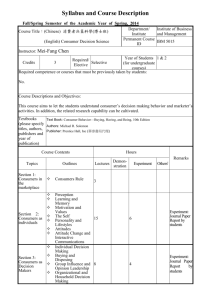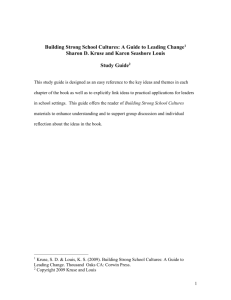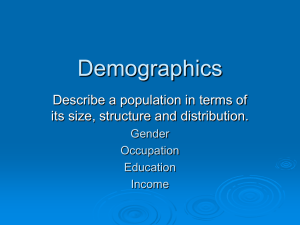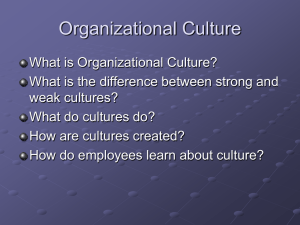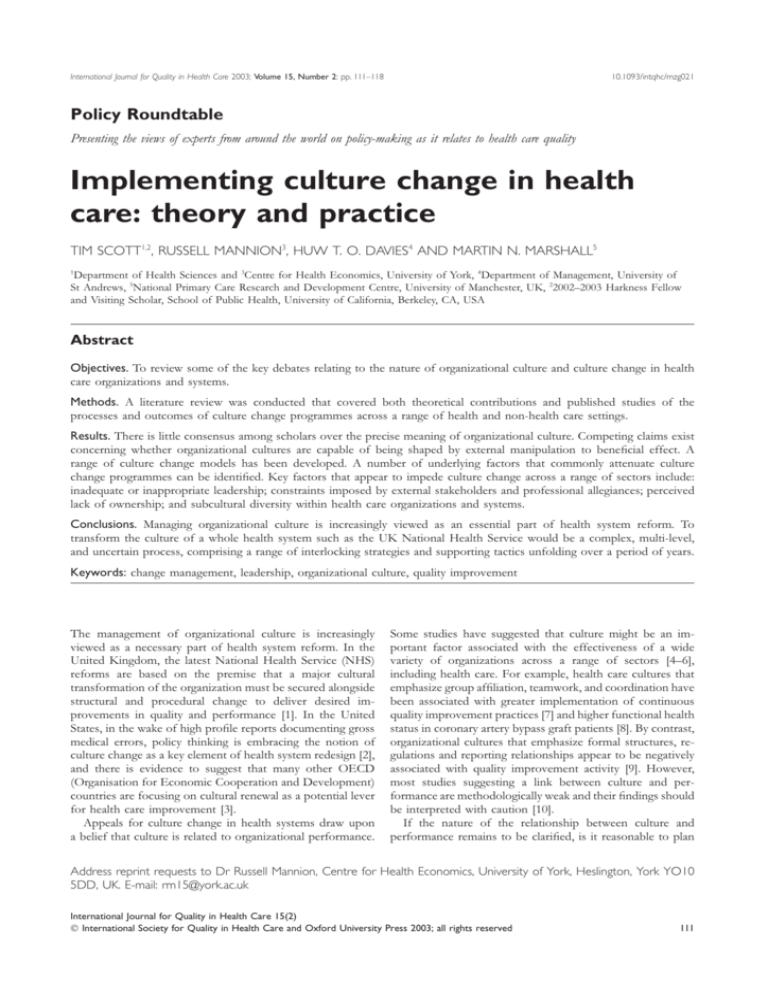
International Journal for Quality in Health Care 2003; Volume 15, Number 2: pp. 111–118
10.1093/intqhc/mzg021
Policy Roundtable
Presenting the views of experts from around the world on policy-making as it relates to health care quality
Implementing culture change in health
care: theory and practice
TIM SCOTT1,2, RUSSELL MANNION3, HUW T. O. DAVIES4 AND MARTIN N. MARSHALL5
1
Department of Health Sciences and 3Centre for Health Economics, University of York, 4Department of Management, University of
St Andrews, 5National Primary Care Research and Development Centre, University of Manchester, UK, 22002–2003 Harkness Fellow
and Visiting Scholar, School of Public Health, University of California, Berkeley, CA, USA
Abstract
Objectives. To review some of the key debates relating to the nature of organizational culture and culture change in health
care organizations and systems.
Methods. A literature review was conducted that covered both theoretical contributions and published studies of the
processes and outcomes of culture change programmes across a range of health and non-health care settings.
Results. There is little consensus among scholars over the precise meaning of organizational culture. Competing claims exist
concerning whether organizational cultures are capable of being shaped by external manipulation to beneficial effect. A
range of culture change models has been developed. A number of underlying factors that commonly attenuate culture
change programmes can be identified. Key factors that appear to impede culture change across a range of sectors include:
inadequate or inappropriate leadership; constraints imposed by external stakeholders and professional allegiances; perceived
lack of ownership; and subcultural diversity within health care organizations and systems.
Conclusions. Managing organizational culture is increasingly viewed as an essential part of health system reform. To
transform the culture of a whole health system such as the UK National Health Service would be a complex, multi-level,
and uncertain process, comprising a range of interlocking strategies and supporting tactics unfolding over a period of years.
Keywords: change management, leadership, organizational culture, quality improvement
The management of organizational culture is increasingly
viewed as a necessary part of health system reform. In the
United Kingdom, the latest National Health Service (NHS)
reforms are based on the premise that a major cultural
transformation of the organization must be secured alongside
structural and procedural change to deliver desired improvements in quality and performance [1]. In the United
States, in the wake of high profile reports documenting gross
medical errors, policy thinking is embracing the notion of
culture change as a key element of health system redesign [2],
and there is evidence to suggest that many other OECD
(Organisation for Economic Cooperation and Development)
countries are focusing on cultural renewal as a potential lever
for health care improvement [3].
Appeals for culture change in health systems draw upon
a belief that culture is related to organizational performance.
Some studies have suggested that culture might be an important factor associated with the effectiveness of a wide
variety of organizations across a range of sectors [4–6],
including health care. For example, health care cultures that
emphasize group affiliation, teamwork, and coordination have
been associated with greater implementation of continuous
quality improvement practices [7] and higher functional health
status in coronary artery bypass graft patients [8]. By contrast,
organizational cultures that emphasize formal structures, regulations and reporting relationships appear to be negatively
associated with quality improvement activity [9]. However,
most studies suggesting a link between culture and performance are methodologically weak and their findings should
be interpreted with caution [10].
If the nature of the relationship between culture and
performance remains to be clarified, is it reasonable to plan
Address reprint requests to Dr Russell Mannion, Centre for Health Economics, University of York, Heslington, York YO10
5DD, UK. E-mail: rm15@york.ac.uk
International Journal for Quality in Health Care 15(2)
International Society for Quality in Health Care and Oxford University Press 2003; all rights reserved
111
T. Scott et al.
interventions to instil those cultural attributes thought to
underpin continuous performance improvement? This begs
other questions, such as what is organizational culture? Are
organizational cultures capable of being shaped by external
manipulation? If so, what strategies are available to managers
wishing to inculcate an appropriate organizational culture? In
this article we aim to shed some light on these issues. We
review key theoretical debates on the nature of organizational
culture(s) and consider what practical strategies are open to
health care organizations to implement culture change. The
literature discussed formed part of a larger project, including
a systematic review of literature on culture and performance
in health care and non-health care settings [10–12,32]. The
systematic literature search was conducted using Medline,
CINAHL, Helmis, PsychLit, DHdata, and the database of
the King’s Fund in London, using the phrase ‘organizational
culture’. The information presented in this article is drawn
from the systematic review, supplementary reading, and the
advice of 30 experts in health services policy and management
research in the UK and USA.
Organizational culture
1. Origins and development
There is little consensus among scholars over the precise
meaning of ‘organizational culture’. The term ‘culture’ is
derived from the Latin, meaning to tend crops or animals [13].
Early in the last century social anthropologists applied a
culture metaphor to describe processes of socialization
through family, community, educational, religious, and other
institutions [14]. The idea that an organization’s effectiveness
can vary as a function of its culture can be traced back at
least as far as the Hawthorne studies [15] and related work.
Those studies observed how the informal, social dimension
of enterprise mediated between organizational structures and
performance, and how those dimensions could be manipulated to affect employee effort and commitment. This
interest in the organization as a social institution evolved into
their study as microsocieties or -cultures [16]. In the postwar period, a number of researchers, including behavioural
economists [17], industrial sociologists [18], and organizational
psychologists, emphasized the importance of culture in shaping organizational behaviour. However, it was not until the
1980s that the concept entered mainstream management
thinking via the influence of a number of best selling
management handbooks, which popularized the notion that
culture was a critical determinant of organizational
performance [19–21].
We focus here on the implications of using culture change
as a lever for performance improvement. However, we are
aware of the limitations of the managerialist perspective and
refer interested readers to a number of excellent scholarly
publications that explore in-depth a range of theoretical
stances and epistemological positions on the nature of organizational culture and the feasibility of managed culture
change [22–24].
112
2. Conceptual frameworks
Organizational culture has been described as perhaps the
most difficult of organizational concepts to define [25].
The management literature is replete with overlapping and
competing definitions, a situation that has been referred to
as ‘an embarrassment of definitional riches’ [22].
Conventionally the culture literature is divided into two
broad streams [26]. One stream approaches culture as an
‘attribute’, something an organization ‘has’, along with other
attributes such as structure and strategy. Another stream of
literature regards culture more globally as defining the whole
character and experience of organizational life, i.e. what the
organization ‘is’. Here organizations are construed as cultures
existing in, and reproduced through, the social interaction of
participants. Some scholars view the ‘organization as culture’
approach as but one of a range of paradigms used in
organizational analysis. From that relativist perspective, a
global definition of organizational culture may be termed as
the ‘culture as metaphor’ approach.
The distinction between viewing culture as either an attribute, a defining quality, or a metaphor has important policy
implications. The view of culture as an attribute has been
instrumentally interpreted as an independent variable capable
of manipulation to satisfy organizational objectives. From
that perspective, culture change is viewed as a means to
commercial or other technical ends and comprises a range
of activities directed at ‘overhauling’ or ‘re-engineering’ an
organization’s value system (Table 1). Much popular management literature adopts this approach. If, by contrast,
organizations are approached as cultural systems, culture
becomes the defining context by which the meaning of
organizational attributes is revealed. Then, change agents are
offered fewer levers to influence the formation of desirable
cultures. Indeed the whole emphasis shifts from what organizations accomplish to a cultural anthropological understanding of how organizations are socially accomplished and
reproduced.
These different conceptualizations generate rival claims as
to the nature and feasibility of planned culture change. For
the purposes of this paper we tread a middle path between
the two dominant approaches by treating an organization’s
culture is an emergent property, concomitant with its status
as a social institution [27]. By this definition, culture is not
assumed a priori to be controllable. Instead we assume that
its main characteristics can at least be described and assessed
in terms of their functional contribution to broader managerial
and organizational objectives.
3. Subcultures
The management literature on organizational culture has
tended to assert a relationship between ‘strong’, unified
cultures and commercial success. Yet observation suggests
that few large, complex organizations are likely to be characterized by a single dominant culture. Moreover, there is
no convincing evidence that a unitary culture yields higher
performance than a pluralistic one. Where organizations are
differentiated along clear occupational lines, as health care
Policy Roundtable
Table 1 Key differences between approaches based on culture as an ‘attribute’ and culture as a ‘metaphor’
Culture as an attribute
Culture as a metaphor
.............................................................................................................................................................................................................................
Epistemological assumptions
Positivist
Phenomenological
Disciplinary base
Anthropology/biology
Social psychology
Theory of cultural cohesion
Single, coherent culture
Coexisting subcultures
Theory of organizational order
Provides an adaptive regulating
mechanism to maintain status quo
Cultural conflicts can engender change
Creation and transmission of
culture
Directed by actions of senior staff to
change artefacts and espoused ideology
Reproduced by all culture members
through their ongoing negotiation of
symbols and artefacts
Culture change agents
Senior management only manipulate
culture to meet corporate objectives
Managers, as well as other
organization members, all seek to
influence the cultural direction of the
organization
organizations have traditionally been, a number of coexisting
subcultures are likely to be identified. Subcultures may share
a common orientation and similar espoused values, but there
may also be disparate subcultures that clash or maintain an
uneasy symbiosis [28]. Researchers have adopted two broad
frameworks for studying organizational subcultures. The first
defines subcultures relative to an organization’s overall cultural
patterns, especially its dominant values [28]. From this perspective, subcultures are classified in terms of whether they
support, deny, or simply coexist alongside the values of
the dominant culture (Figure 1). The second framework
acknowledges that subcultures relate to occupational, departmental, ward, speciality, clinical network, and other affiliations. Arguably, these two perspectives need to be
synthesized, as elements of both are likely to be found within
an organization. For example, the NHS is a distinctly British
institution with a recognizable overall identity and certain
apparent core values. Within that overall ‘NHS culture’, a
number of distinct subcultures can be discerned whose
relationship to the overall organizational culture is hard to
disentangle. These subcultures can be divided into a number
of non-mutually exclusive categories (Figure 2).
Managing culture change
1. Reform or transformation
Culture change strategies may be targeted at either first order
or second order change [29]. During first order change the
objective is to ‘do what you do better’. According to Deal
and Kennedy [20] many commercial organizations have maintained a competitive advantage by pursuing a policy of
‘cultural continuity’, capitalizing on the lessons, traditions,
and working practices that have served the organizational
well over a period of time. There the focus is on evolutionary
growth or quantitative reproduction and repetition (more of
the same). In contrast, second order, qualitative growth
(something different) is more appropriate if an existing culture
has begun to stagnate and its complete overhaul is required [30]. Second order change is often invoked in response
to a growing crisis or deficiency in the existing culture, which
cannot be addressed adequately by a change in culture but
rather demands a fundamental change of culture. If politicians
and management gurus are to be believed, health systems in
many countries stand perennially on the threshold of such
fundamental change.
2. Developing strategies for cultural change
Various models to understand and guide culture change have
been developed [22]. Bate highlights the key dimensions to
be targeted in a culture change strategy, as follows [30].
The structural dimension. To be successful a culture change
programme must take account of the nature of the culture
to be changed. Only after an effective diagnosis or cultural
audit has revealed how the current order is sustained can
effective change management strategies be deployed. As
Brooks and Bate maintain, many attempts at changing organizational cultures are strong on prescription but lamentably
weak on diagnosis [31]. Such a diagnosis would proceed by
first acquiring an appreciation of the currently prevailing
culture. A range of quantitative and qualitative assessment
tools have been developed to help decipher an organization’s
culture. These have been used extensively across different
industries and settings, including health care organizations.
However, these instruments should be used cautiously
as there is wide variance in their established validity and
reliability [32].
The process dimension. If cultures develop spontaneously, as
an emergent model suggests, how they change is a key question.
Bate [30] applies a sailing metaphor based on wave momenta
to illustrate spontaneous change. If the latest cultural wave
appears to be going in the right direction (a virtuous momentum) then it may be possible to ride the wave using its own
energy to deliver the organization to its desired destination.
113
T. Scott et al.
Figure 1 Classification of subcultures.
If the prevailing wave is not going in the desired direction,
at least three alternative strategies are possible. First, to deflect
waves using their own momenta (re-framing strategies). Secondly, to wait until the most powerful waves have subsided
and then create new ones (new-wave strategies). And thirdly,
to wait until a new wave is going in the desired direction
and ‘hitch a ride’ (opportunistic strategies).
The contextual dimension. It is important to assess the ‘fit’ or
alignment between a culture and the wider environment. As
the external environment changes so must the internal culture
to avoid obsolescence. This adaptive approach involves an
assessment of ‘cultural lag’ or ‘strategic drift’ [33] to gauge
the gap between the culture in use and the required culture.
A number of highly critical reports on quality failings within
the NHS have highlighted the need to reduce the dissonance
between the prevailing culture of the NHS and broader
societal changes occurring since its inception over 50 years
ago [34].
3. Overcoming resistance to planned culture
change
All strategies of culture change need to be mindful of the
possible barriers that serve to block or attenuate purposeful
change. Key sources of organizational inertia and resistance
include:
Lack of ownership. As change often evokes a sense of loss
[35], reactions to change by individuals or professional groups
can be negative and unpredictable. Even a few disaffected
individuals can cause disruption, whilst a disaffected workforce or professional grouping is a recipe for organizational
disaster. The implication is that unless a critical mass of
114
employees ‘buy into’ a culture change programme, such
initiatives are likely to fail.
Complexity. Organization culture is transmitted and embedded via a wide range of media, including established
working procedures and practices (e.g. rewards ceremonies,
exemplary individuals, written documentation, physical
spaces, professional demarcations, shift patterns). It is unrealistic to expect culture change strategies to be effective on
all these fronts simultaneously. Successful strategies require
realistic time frames to implement the types of complex and
multi-level changes required. It would appear that the UK
government’s 10-year programme of reform for the NHS is
a tacit acknowledgement that cultural transformation cannot
be wrought overnight on an organization with such well
established practices and values [36].
External influence. The influence of outside interests may cut
across and sometimes work against efforts towards internal
reform. Culture change strategies need to heed the constraints
posed by external stakeholders in determining the values and
behaviour of health professionals [37]. In the UK it is accepted
that attempts to change the culture of the NHS may also
need to target external bodies such as the Royal Medical
Colleges, which exert control over training and influence the
internalization of professional core values [38]. Similarly,
research in Australian hospitals has shown that professionbased attitudes and beliefs have hampered the efforts of health
authorities to promote more outcome-focused approaches to
health care organization and management [37]. More widely,
the Romanow Commission acknowledges the crucial importance for successful health care reform of working with, not
against, core public values [39].
Policy Roundtable
Figure 2 Varieties of subculture in the UK National Health Service.
Lack of appropriate leadership. Leadership plays a central role
in any cultural transformation. Inadequate or inappropriate
leadership has been identified as a key factor when attempts
to change culture fail [40]. Two main styles of leadership are
widely recognized: ‘transactional’ leadership, based around
securing organizational compliance and control by using
material motivational factors like reward systems; and ‘transformational’ leadership processes, which inspire cognitive
change by redefining the meaning of information to which
organizational members are exposed (but not necessarily
sensitized). Integrating these two styles is a necessary and
challenging project. For example, it may be possible to
115
T. Scott et al.
Figure 3 The meeting of cultures: achieving a cultural fit. Derived and expanded from a classificatory scheme on
strategic alliances developed by Child and Faulkner [42] and based on original work by Tung [43]. Figure reproduced
with permission.
manipulate employment to reward behaviour patterns appropriate to patient-centred care. But such a naive behaviourist (transactional) approach would be insufficient.
Leadership is also required to help transform practitioners’
cognitive apprehension of the status and relationships of
participants in care-giving situations. In this way practitioners
will not only be rewarded for appropriate behaviour, they
will view their roles relative both to one another and to
patients and their families in a different light. Thus, the
patient-centred model of care is not just about modifying
familiar behaviour, it is also about radically redefining participants’ interpretations and experiences of health care. This
cognitive behavioural or transformational approach to leadership defines cultural as opposed to structural organizational
change [41].
Cultural diversity. As we have noted, health care organizations are likely to comprise competing and overlapping
116
professional subgroups. Thus, a key challenge to culture
change programmes is to consider carefully the impact of
change on specific groups (e.g. doctors, nurses and
other health professionals, and managers) and to design
appropriate policies to accommodate this. Building on the
work of Tung [43], Child and Faulkner [42] have developed
a useful typology to assess approaches to managing
organizational change in the face of cultural diversity. Their
analysis is structured according to two fundamental choices.
The first concerns whether one subgroup’s culture should
dominate. The second relates to the decision either to
integrate different subcultures (in order to derive synergy
between them) or to segregate the various subcultures
(with the aim of avoiding conflict or efforts devoted to
culture management). These strategic choices give rise to
four possible bases for accommodating cultural diversity
(Figure 3). The first three offer some scope for establishing
Policy Roundtable
a cultural fit, whilst the fourth may give rise to serious
dysfunctional consequences.
Dysfunctional consequences. In addition to, or instead of, driving
beneficial outcomes, culture change policies may induce a
range of unintended and dysfunctional consequences [44].
This is seen, for example, in the range of adverse behaviours
generated by the rise of a performance management culture
in the UK NHS [45]. For example, qualitative case study
research has revealed that in addition to promoting constructive change, the increased emphasis on performance
targets has resulted in: a concentration on areas that are
measured to the detriment of other important areas, especially
qualitative aspects of care that defy quantification (tunnel
vision); the deliberate misrepresentation of data, including
creative accounting and fraud (misrepresentation); a lack of
ambition for quality and performance improvement brought
about by a perceived ‘satisfactory’ league table ranking (complacency); and the concentration on short-term issues, to the
exclusion of long-term criteria that may only show up in
performance measures in many years’ time (myopia). There
are also fears that similar problems are emerging because of
the culture of public reporting that has grown in the US [46].
Therefore, it is imperative that culture change policies are
not monitored only in terms of the extent to which they
foster constructive change, but also in terms of the perverse
side effects that they inadvertently generate.
Contributions
R.M. devised the study in conjunction with H.D. and M.M.
T.S. conducted the literature review and wrote the first draft
of the findings of the review. R.M. wrote the first draft
of this paper and all authors contributed to subsequent
drafts.
Acknowledgements
This study was funded by the UK Department of Health
through core support for the Centre for Health Economics,
University of York, and the National Primary Care Research
and Development Centre, University of Manchester. The
views expressed in the paper represent those of the authors
and not necessarily those of the UK Department of Health.
T.S. contributed to the final draft during a Harkness
Fellowship funded by the Commonwealth Fund of New
York.
References
1. Department of Health. Shifting the Balance of Power within the NHS:
Securing Delivery. London: Department of Health, 2000.
2. Institute of Medicine. To Err is Human: Building a Safer Health
System. Washington DC: National Academy Press, 1999.
Concluding remarks
There is increasing international interest in managing organizational culture as a lever for health care improvement.
Changing the organizational culture along with its structure
has become a familiar prescription in health system reform.
Nowhere is this more apparent than in the UK, where the
centralized administration of the NHS has allowed opportunities for the national government to experiment with
a ‘top down’ approach to instilling new values, beliefs, and
working relationships. Yet planned culture change is a difficult,
uncertain, and risky enterprise. Professional values, affirmed
over centuries and woven into the fabric of health care
organizations, are resilient enough to frustrate many attempts
to ‘engineer’ change from above.
In this article we have sought to sharpen thinking around
the theory and feasibility of culture change in health care.
We have: (1) argued that organizational culture is a complex
and contested terrain; (2) emphasized the importance of
distinguishing between different types of subcultures; (3)
highlighted the crucial role of leadership; and (4) outlined
common barriers to culture change and suggested a variety
of approaches to surmounting these. We end on a note of
caution for those planning cultural reform: efforts targeted
at culture change may not always generate the anticipated
organizational outcomes. Indeed, experience in health care
and other sectors suggests that such attempts have the
potential to induce seriously dysfunctional as well as functional
consequences.
3. Smith P (ed.). Measuring Up: Improving Health System Performance
in OECD Countries. OECD: Paris, 2002.
4. Cameron K, Freeman S. Culture congruence, strength and type.
Res Org Change Dev 1991; 5: 23–58.
5. Kotter J, Heskett J. Corporate Culture and Performance. New York:
Macmillan, 1992.
6. Driscoll A, Morris J. Stepping out: rhetorical devices and culture
change management in the UK civil service. Publ Admin 2001;
79: 803–824.
7. Shortell S, O’Brien J, Carman J et al. Assessing the impact
of continuous quality improvement/total quality management:
concept versus implementation. Health Serv Res 1995; 30: 377–
401.
8. Shortell S, Jones R, Rademaker A et al. Assessing the impact
of total quality management and organizational culture on
multiple outcomes of care for coronary artery bypass graft
surgery patients. Med Care 2000; 38: 207–217.
9. Ferlie E, Shortell S. Improving the quality of health care in the
United Kingdom and the United States: a framework for change.
Milbank Q 2001; 79: 281–316.
10. Scott T, Mannion R, Davies H, Marshall M. Does organizational
culture influence health care performance? J Health Serv Res
Policy 2003; in press.
11. Scott T, Mannion R, Davies H, Marshall M. Organisational Culture
and Health Care Performance: a Review of the Theory, Instruments and
Evidence. Report to the Department of Health. University of York:
Centre for Health Economics, 2001.
117
T. Scott et al.
12. Scott T, Mannion R, Davies H, Marshall M. Organisational Culture
and Health Care Performance: a Review of the Theory, Instruments and
Evidence. Oxford: Radcliffe Medical Press (in press).
13. Hofstede G. Culture’s Consequences: International Differences in Work
Related Values. Beverly Hills, CA: Sage, 1980.
14. Williams R. Keywords: a vocabulary of culture and society. New
York: Oxford University Press, 1983.
15. Roethlisberger F, Dixon W. Management and the Worker: an Account
of a Research Program Conducted by the Western Electric Company.
Chicago, Cambridge: Hawthorne Works, Harvard University
Press, 1939.
16. Barnard C. The Functions of the Executive. Cambridge, MA: Harvard
University Press, 1938.
17. Cyert R, March J. A Behavioural Theory of the Firm. Englewood
Cliffs, NJ: Prentice Hall, 1963.
18. Selznick P. TVA and the Grass Roots: a Study of Politics and
Organisation. Berkeley: University of California Press, 1947.
19. Peters T, Waterman RH. In Search of Excellence: Lessons from
America’s Best-run Company. New York: Harper and Row, 1982.
20. Deal T, Kennedy A. Corporate Cultures. Reading, MA: AddisonWesley, 1982.
21. Allen F, Kraft C. The Organizational Unconscious: How to Create the
Corporate Culture you Want and Need. Englewood Cliffs, NJ:
Prentice Hall, 1982.
31. Brooks I, Bate P. The problems of affecting change within the
British Civil Service. In: Bresnen M, Davies A, Whipp R, eds.
The Challenge of Change: the Theory and Practice of Organizational
Transformations. London: Sage, 1992.
32. Scott T, Mannion R, Davies H, Marshall M. The quantitative
assessment of organisational culture. Health Serv Res 2003; in
press.
33. Johnson G. Managing Strategic Change—a frames and formulae
approach. Paper presented at the Strategic Management Society
Conference, October. Philadelphia, 1984.
34. Learning from Bristol: the report of the public inquiry into
children’s heart surgery at the Bristol Royal Infirmary 1984–95.
Report No. Cm 5207, 2001.
35. Marris P. Loss and Change. London: Routledge & Kegan Paul,
1986.
36. The NHS Plan. Report No. Cm 4818. Norwich: The Stationery
Office, 2000.
37. Degeling P, Kennedy J, Hill M. Do professional subcultures set
the limits of hospital reform. Clinician Man 1998; 7: 89–98.
38. Davies H, Nutley S, Mannion R. Organizational culture and
health care quality. Qual Health Care 2000; 9: 111–119.
39. Roy J, Romanow QC, Commissioner. Shape the Future of health
Care: Interim Report of the Commission on the Future of Health Care
in Canada. Saskatoon, Canada, February 2002.
40. Schien E. Organizational Culture and Leadership: a Dynamic View.
California: Jossey-Bass, 1995.
22. Brown A. Organizational Culture. London: Pitman, 1995.
23. Martin J. Organizational Culture: Mapping the Terrain. London: Sage,
2002.
41. Goodwin N. Leadership and the UK health service. Health Pol
2000; 51: 49–60.
24. Alvesson M. Understanding Organizational Culture. London: Sage,
2002.
42. Child J, Faulkner D. Strategies of Co-operation: Managing Alliances,
Networks and Joint Ventures. Oxford: Oxford University Press,
1998.
25. Hatch M. Organization Theory: Modern, Symbolic and Postmodern
Perspectives. Oxford: Oxford University Press, 1997.
43. Tung RL. Managing Cross-National and Intra National Diversity.
Hum Res Man 1993; 32: 461–477.
26. Smirchich L. Concepts of culture in organisational analysis. Adm
Sci Q 1983; 28: 328–358.
44. Harris LC, Ogbonna E. The unintended consequences of culture
interventions: a study of unexpected outcomes. Br J Manag
2002; 13: 31–49.
27. Selznick P. Leadership in Administration: a Sociological Interpretation.
New York: Harper & Row, 1957.
28. Martin J, Seihl C. Organizational Culture and Counter Culture:
An Uneasy Symbiosis. Organ Dyn 1983; Autumn: 52–64.
29. Langfield-Smith K. Organisational culture and control. In: Berry
A, Broadbent J, Otley D, eds. Management Control: Theories, Issues
and Practices. London: Macmillan Press Ltd, 1995.
30. Bate P. Strategies for Cultural Change. Oxford: Butterworth-Heinemann, 1999.
118
45. Mannion R, Goddard M. Performance measurement and improvement in health care. Appl Health Econ Health Pol 2002; 1:
13–23.
46. Mannion R, Davies HTO. Reporting health care performance:
learning from the past, prospects for the future. J Eval Clin
Pract 2002; 8: 215–228.
Accepted for publication 17 December 2002

